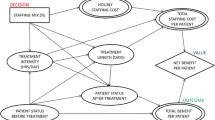Abstract
The goal of “treatment on demand” is to allow all those seeking substance abuse treatment immediate entry into a program. Surprisingly, little is understood regarding the relationship between the demand for treatment, queues, waiting times and treatment admission rates, and treatment capacity. Nor has the increase in treatment capacity required to eliminate drug treatment queues, along with the expected benefits and costs of such an expansion, been studied carefully. In this paper, we present a mathematical model of drug treatment flows for systems where the demand for treatment greatly exceeds available supply. The model produces estimates of queue lengths, waiting times and treatment admission probabilities for any given treatment capacity, and suggests the capacity needed to achieve treatment on demand. The model also enables one to contrast the likely costs and benefits of changes in treatment capacity. We illustrate the model using San Francisco as a case study.
Similar content being viewed by others
References
D.R. Gerstein and H.J. Harwood, eds., Treating Drug Problems (National Academy Press, Washington, DC, 1990).
Substance Abuse and Mental Health Services Administration, National Treatment Improvement Evaluation Study (Department of Health and Human Services, Center for Abuse Treatment, Washington, DC, 1996).
C.P. Rydell, J.P. Caulkins and S.S. Everingham, Enforcement or treatment? Modeling the relative efficacy of alternatives for controlling cocaine, Operations Research 44 (1996) 687–695.
D.R. Gerstein, R.A. Johnson, H.J. Harwood, D. Fountain, N. Suter and K. Malley, Evaluating Recovery Services: The California Drug and Alcohol Treatment Assessment, General Report (National Opinion Research Center, Chicago, 1994).
National Association of State Alcohol and Drug Abuse Directors, Estimated Number of Individuals Needing Treatment (National Association of State Alcohol and Drug Abuse Directors, Washington, DC, 1996).
United States General Accounting Office, Drug Treatment: Some Clinics Not Meeting Goal of Prompt Treatment for Intravenous Drug Users (Publication No. GAO/HRD-90-80BR, General Accounting Office, Washington, DC, 1990).
S. Shane, Cost of addiction carries “hidden tax”: city doubles spending on treatment to cut price paid by public, Baltimore Sun (April 30, 1998) 1A.
D. Weikel, A grueling waiting game for addicts seeking help: drug treatment is highly cost-effective, data show, but programs for the indigent fail to meet enormous demand, Los Angeles Times (April 24, 1997) 1.
W. King, Prompt treatment key to recovery - but detox programs now in country aren't large enough to meet demand, Seattle Times (January 21, 1998) A12.
C. Bowman, $20 million plan to help S.F. addicts - health officials back “treatment on demand”, San Francisco Chronicle (November 8, 1996) A21.
D.C. Des Jarlais, Personal communication to Edward H. Kaplan via e-mail (May 12, 1998).
R.C. Bailiey, Y.-I. Hser, S.-C. Hsieh and M.D. Anglin, Influences affecting maintenance and cessation of narcotics addiction, The Journal of Drug Issues 24 (1994) 249–272.
H.-I. Hser, K. Yamaguchi, H. Chen and M.D. Anglin, Effects of interventions on relapse to narcotics addiction: an event-history analysis, Evaluation Review 19 (1995) 123–140.
M.G. Dekimpe, L.M. Van De Gucht, D.M. Hanssens and K.I. Powers, Long-run abstinence after narcotics abuse: what are the odds?, Management Science 44 (1998) 1478–1492.
San Francisco Department of Public Health, Supporting the Department of Public Health's Substance Abuse Treatment on Demand: First Steps Plan to Guide the Augmentation of Alcohol and Drug Services in Fiscal Year 1997-98, May 20, 1997 (retrieved via http://www.dph.sf.ca.us/hcres/html/hc resolutions 52.htm on January 26, 1999).
M. Schlesinger and R. Dorwart, Falling between the cracks: failing national strategies for the treatment of substance abuse, Daedelus 121 (1992) 195–237.
C. Marinucci, Brown wrong about drug treatment, advocates say, San Francisco Chronicle (October 17, 1997) A21.
H.J. Harwood, R.L. Hubbard, J.J. Collins and J.V. Rachal, The costs of crime and the benefits of drug abuse treatment: a cost-benefit analysis using TOPS data, NIDA Research Monograph 86 (1988) 209–235
J.D. Kalbfleisch and R.L. Prentice, The Statistical Analysis of Failure Time Data (Wiley, New York, 1980).
Substance Abuse and Mental Health Services Administration, National Household Survey on Drug Abuse: Population Estimates 1994 (Substance Abuse and Mental Health Services Administration, Washington, DC, 1994).
J.P. Walters, Prepared Testimony of John P. Walters, Former Acting Director and Deputy Director for Supply Reduction, Office of National Drug Control Policy, Before the House Committee on International Relations, April 29 (Federal News Service, Washington, DC, 1998).
Author information
Authors and Affiliations
Rights and permissions
About this article
Cite this article
Kaplan, E.H., Johri, M. Treatment on demand: an operational model. Health Care Management Science 3, 171–183 (2000). https://doi.org/10.1023/A:1019001726188
Issue Date:
DOI: https://doi.org/10.1023/A:1019001726188




